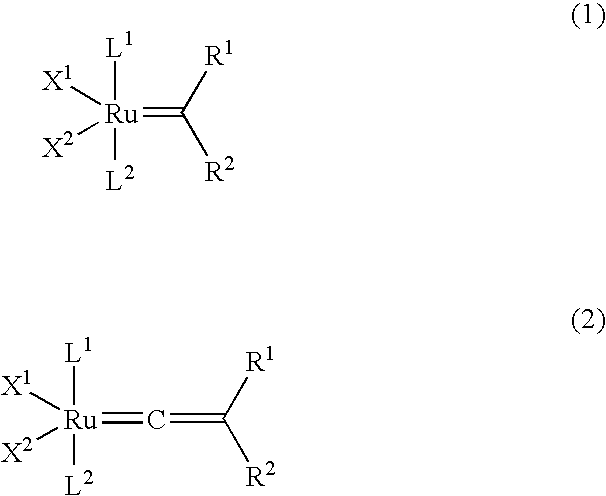Polymerizable composition and formed article using the same
a technology of polymerizable composition and formed article, which is applied in the direction of organic dyes, etc., can solve the problems of increasing the viscosity of polymerizable composition, breaking parts and wiring, and worsening the injection of composition into molds, so as to improve the permeability of composition and improve the permeability , the effect of excellent fluidity
- Summary
- Abstract
- Description
- Claims
- Application Information
AI Technical Summary
Benefits of technology
Problems solved by technology
Method used
Image
Examples
synthesis example 1
Production of Acid Anhydride-Containing Polymer
[0112] Put into a reaction vessel purged by nitrogen were 100 parts of cyclopentane as a solvent and 1.2 parts of aluminum trichloride as a polymeization catalyst, and the mixture was heated up to 50° C. Into the heated mixture, 100 parts of a mixed monomer consisting of 57 parts of 1,3-pentadiene, 28 parts of cyclopentene and 15 parts of isobutene was continuously dropwised over 60 minutes and thereafter, stirring the mixture for 10 minutes and then, methanol and aqueous ammonia were added to stop the reaction. Then, the reaction solution was filtered to remove a residual catalyst and then the solvent was removed to obtain a polymer having an alicyclic structure.
[0113] Then, put into a reaction vessel purged with nitrogen were 100 parts of the polymer obtained and 3 parts of maleic anhydride, and the mixture was heated up to 230° C. and was stirred in the melting state for 1 hour to obtain a maleic anhydride-modified alicyclic struct...
synthesis example 2
Production of Hydroxyl Group-Containing Polymer
[0114] Put into a reaction vessel purged by nitrogen were 70 parts of dicyclopentadinene and 30 parts of allyl alcohol, and the mixture was heated up to 260° C. to conduct a thermal polymerization reaction for 4 hours, thereafter the inside of the vessel was evacuated to a vacuum state at 280° C. to remove oligomers such as dicyclopentadiene and tricyclopentadiene to obtain an alicyclic structure-containing polymer (a hydroxyl group-containing polymer) with an hydroxyl value of 205 mgKOH / g, a number-average molecular weight of 380 (a polystyrene conversion value in tetrahydrofuran as a solvent) and a glass transition temperature of 48° C.
example 1
[0115] Dissolved into 3.67 parts of toluene were 0.17 part of benzylidene(1,3-dimesitylimidazolidin-2-ylidene) (tricyclohexylphosphine) ruthenium dichloride and 0.26 part of triphenylphosphine to prepare a catalyst solution with a ruthenium concentration of 0.05 mol / l.
[0116] Then, added into a mixed monomer including 70 parts of 4-tetracyclododecene and 30 parts of 2-norbornene were 1.2 parts of allyl methacrylate as a chain transfer agent, 0.93 part of di-t-butyl peroxide (one minute half-life temperature of 186° C.) as a crosslinking agent, 500 parts of barium titanate (NPO-S, manufactured by FUJI TITANIUM INDUSTRY CO., LTD., an average particle diameter of 1 μm) as a filler, 2.5 parts of an acid anhydride group-containing polymer obtained in Synthetic Example 1, 2.5 pats of a titanate coupling agent (KR-TTS, manufactured by Ajinomoto Co., Inc.), 2 parts of a phenol antioxidant (a trade name IRGANOX 1330, manufactured by Chiba Speciality Chemicals) and 1 part of diphenyldimethoxy...
PUM
| Property | Measurement | Unit |
|---|---|---|
| acid value | aaaaa | aaaaa |
| particle diameter | aaaaa | aaaaa |
| particle diameter | aaaaa | aaaaa |
Abstract
Description
Claims
Application Information
 Login to View More
Login to View More - R&D
- Intellectual Property
- Life Sciences
- Materials
- Tech Scout
- Unparalleled Data Quality
- Higher Quality Content
- 60% Fewer Hallucinations
Browse by: Latest US Patents, China's latest patents, Technical Efficacy Thesaurus, Application Domain, Technology Topic, Popular Technical Reports.
© 2025 PatSnap. All rights reserved.Legal|Privacy policy|Modern Slavery Act Transparency Statement|Sitemap|About US| Contact US: help@patsnap.com


